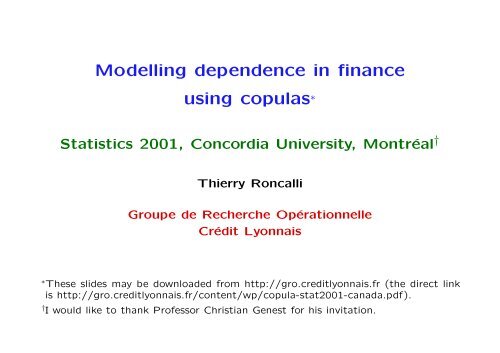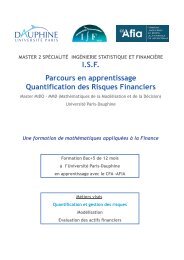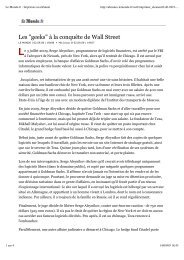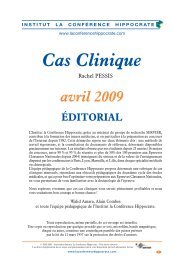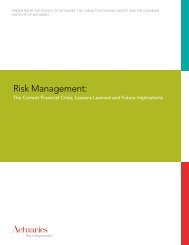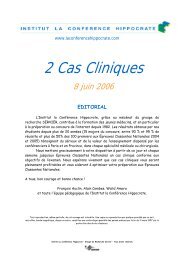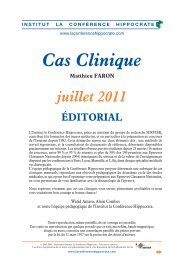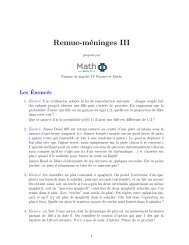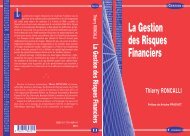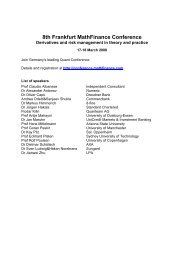Modelling dependence in finance using copulas - Thierry Roncalli's ...
Modelling dependence in finance using copulas - Thierry Roncalli's ...
Modelling dependence in finance using copulas - Thierry Roncalli's ...
Create successful ePaper yourself
Turn your PDF publications into a flip-book with our unique Google optimized e-Paper software.
<strong>Modell<strong>in</strong>g</strong> <strong>dependence</strong> <strong>in</strong> f<strong>in</strong>ance<br />
us<strong>in</strong>g <strong>copulas</strong> ∗<br />
Statistics 2001, Concordia University, Montréal †<br />
<strong>Thierry</strong> Roncalli<br />
Groupe de Recherche Opérationnelle<br />
Crédit Lyonnais<br />
∗ These slides may be downloaded from http://gro.creditlyonnais.fr (the direct l<strong>in</strong>k<br />
is http://gro.creditlyonnais.fr/content/wp/copula-stat2001-canada.pdf).<br />
† I would like to thank Professor Christian Genest for his <strong>in</strong>vitation.
Agenda<br />
1. The Gaussian assumption <strong>in</strong> f<strong>in</strong>ance<br />
2. Copulas and multivariate f<strong>in</strong>ancial models<br />
3. An open field for risk management<br />
• Market risk<br />
• Operational risk<br />
• Credit risk<br />
4. New pric<strong>in</strong>g methods with <strong>copulas</strong><br />
• Multi-asset options<br />
• Credit derivatives<br />
<strong>Modell<strong>in</strong>g</strong> <strong>dependence</strong> <strong>in</strong> f<strong>in</strong>ance us<strong>in</strong>g <strong>copulas</strong> 1
1 The Gaussian assumption <strong>in</strong> f<strong>in</strong>ance<br />
We consider the ‘universal’ f<strong>in</strong>ancial model. Let (Ω, F, P) be the<br />
probability space. The asset prices processes S 1 (t) and S 2 (t) are<br />
given by the SDE representation<br />
{<br />
dS1 (t) = µ 1 S 1 (t) dt + σ 1 S 1 (t) dW 1 (t)<br />
dS 2 (t) = µ 2 S 2 (t) dt + σ 2 S 2 (t) dW 2 (t)<br />
where W 1 (t) and W 2 (t) are two F t –brownian motions with<br />
E [ W 1 (t) W 2 (t) | F t0<br />
]<br />
= ρ (t − t0 )<br />
It comes that the logarithm return of assets is gaussian (= Gaussian<br />
assumption <strong>in</strong> f<strong>in</strong>ance).<br />
Empirical facts: Asset returns are not gaussian (see the f<strong>in</strong>ancial<br />
econometric literature on ARCH, long-memory, Lévy processes, etc.).<br />
Problem: Univariate f<strong>in</strong>ancial models are not gaussian, but<br />
multivariate f<strong>in</strong>ancial models are gaussian!<br />
<strong>Modell<strong>in</strong>g</strong> <strong>dependence</strong> <strong>in</strong> f<strong>in</strong>ance us<strong>in</strong>g <strong>copulas</strong><br />
The Gaussian assumption <strong>in</strong> f<strong>in</strong>ance 1-1
2 Copulas and multivariate f<strong>in</strong>ancial models<br />
1. How to def<strong>in</strong>e multivariate f<strong>in</strong>ancial models compatible with<br />
univariate non-Gaussian f<strong>in</strong>ancial models<br />
Copula = a powerful tool<br />
2. How to obta<strong>in</strong> tractable multivariate f<strong>in</strong>ancial models (<strong>in</strong> terms of<br />
computational time)<br />
3. How to specify multivariate f<strong>in</strong>ancial models which may be<br />
understood/used by the f<strong>in</strong>ance <strong>in</strong>dustry<br />
Copula = a promis<strong>in</strong>g tool<br />
Copulas have been already <strong>in</strong>corporated <strong>in</strong> some software solutions:<br />
• SAS Risk Dimensions<br />
• Palisade @Risk<br />
<strong>Modell<strong>in</strong>g</strong> <strong>dependence</strong> <strong>in</strong> f<strong>in</strong>ance us<strong>in</strong>g <strong>copulas</strong><br />
Copulas and multivariate f<strong>in</strong>ancial models 2-1
2.1 Pearson correlation and <strong>dependence</strong><br />
Pearson correlation ρ = l<strong>in</strong>ear <strong>dependence</strong> measure.<br />
For two given asset prices processes S 1 (t) and S 2 (t) which are GBM,<br />
the range of the correlation is<br />
ρ − ≤ ρ (S 1 (t) , S 2 (t)) ≤ ρ +<br />
with<br />
ρ ± =<br />
exp (±σ 1 σ 2 (t − t 0 )) − 1<br />
√<br />
exp ( σ1 2 (t − t ) √<br />
0) − 1 · exp ( σ2 2 (t − t 0))<br />
− 1<br />
ρ (S 1 (t) , S 2 (t)) = ρ − (resp. ρ + ) ⇔ C 〈S 1 (t) , S 2 (t)〉 = C − (resp.<br />
C + ) ⇔ S 2 (t) = f (S 1 (t)) with f a decreas<strong>in</strong>g (resp. <strong>in</strong>creas<strong>in</strong>g)<br />
function<br />
Perfect <strong>dependence</strong> ≠ |ρ| = 1<br />
<strong>Modell<strong>in</strong>g</strong> <strong>dependence</strong> <strong>in</strong> f<strong>in</strong>ance us<strong>in</strong>g <strong>copulas</strong><br />
Copulas and multivariate f<strong>in</strong>ancial models 2-2
2.2 Copula: a new tool <strong>in</strong> f<strong>in</strong>ance<br />
• <strong>in</strong>troduced by Embrechts et al. [14].<br />
• Market risk: Bouyé et al. [2], Cherub<strong>in</strong>i et al. [8], Durrleman et<br />
al. [13], Embrechts et al. [15], Luciano et al. [24], Tibiletti [33].<br />
• Credit risk: Coutant et al. [11], Frey et al. [17], Georges et al.<br />
[18], Giesecke [19], Hamilton et al. [20], L<strong>in</strong>dskog et al. [23],<br />
Maccar<strong>in</strong>elli et al. [25].<br />
• Operational risk: Ceske et al. [5] [6], Frachot et al. [16].<br />
• Asset prices modell<strong>in</strong>g: Bouyé et al. [4], Malavergne et al. [26],<br />
Patton [27], Rock<strong>in</strong>ger et al. [28], Scaillet [31].<br />
• Credit derivatives pric<strong>in</strong>g: Li [21], Georges et al. [18],<br />
Schönbucher et al. [32].<br />
• Multi-asset options pric<strong>in</strong>g: Bikos [1], Cherub<strong>in</strong>i et al. [7],<br />
Coutant et al. [10], Durrleman [12], Rosenberg [29] [30].<br />
<strong>Modell<strong>in</strong>g</strong> <strong>dependence</strong> <strong>in</strong> f<strong>in</strong>ance us<strong>in</strong>g <strong>copulas</strong><br />
Copulas and multivariate f<strong>in</strong>ancial models 2-3
2.3 Copulas <strong>in</strong> a nutshell<br />
A copula function C is a multivariate probability distribution with<br />
uniform [0, 1] marg<strong>in</strong>s.<br />
C (F 1 (x 1 ) , . . . , F N (x N )) def<strong>in</strong>es a multivariate cdf F with marg<strong>in</strong>s<br />
F 1 , . . . , F N ⇒ F is a probability distribution with given marg<strong>in</strong>als.<br />
The copula function of the random variables (X 1 , . . . , X N ) is<br />
<strong>in</strong>variant under strictly <strong>in</strong>creas<strong>in</strong>g transformations (∂ x h n (x) > 0):<br />
C 〈X 1 , . . . , X N 〉 = C 〈h 1 (X 1 ) , . . . , h N (X N )〉<br />
... the copula is <strong>in</strong>variant while the marg<strong>in</strong>s may be changed at will,<br />
it follows that is precisely the copula which captures those properties<br />
of the jo<strong>in</strong>t distribution which are <strong>in</strong>variant under a.s. strickly<br />
<strong>in</strong>creas<strong>in</strong>g transformations (Schweizer and Wolff [1981]).<br />
⇒ Copula = <strong>dependence</strong> function of r.v. (Deheuvels [1978]).<br />
<strong>Modell<strong>in</strong>g</strong> <strong>dependence</strong> <strong>in</strong> f<strong>in</strong>ance us<strong>in</strong>g <strong>copulas</strong><br />
Copulas and multivariate f<strong>in</strong>ancial models 2-4
2.4 The Normal copula<br />
Two caracteristics <strong>in</strong> f<strong>in</strong>ance: High dimensional problems (e.g. a<br />
portfolio with 1000 securities) and probabilistic properties of the<br />
models (e.g. markovian property).<br />
All the copula functions are not good candidates for f<strong>in</strong>ancial<br />
application <strong>in</strong> an <strong>in</strong>dustry po<strong>in</strong>t of view.<br />
The Normal copula has not yet been extensively studied (see however<br />
Song [2000]). Nevertheless, it may be an ‘<strong>in</strong>dustrial’ copula.<br />
Remark 1 The multivariate normal distribution is very tractable. It<br />
is very easy to estimate the parameters and simulation is<br />
straightforward. Moreover, this distribution has nice properties.<br />
Is it also the case for the Normal copula<br />
<strong>Modell<strong>in</strong>g</strong> <strong>dependence</strong> <strong>in</strong> f<strong>in</strong>ance us<strong>in</strong>g <strong>copulas</strong><br />
Copulas and multivariate f<strong>in</strong>ancial models 2-5
The copula function<br />
C (u; ρ) = Φ ( Φ −1 (u 1 ) , . . . , Φ −1 (u N ) ; ρ )<br />
The density is<br />
c (u; ρ) = |ρ| −1 2 exp<br />
(<br />
− 1 ( 2 ς⊤ ρ −1 − I ) )<br />
ς<br />
with ς = ( Φ −1 (u 1 ) , . . . , Φ −1 (u N ))<br />
.<br />
The Ψ transform<br />
We def<strong>in</strong>e the operator Ψ as follows<br />
Ψ [F] : R −→ R<br />
x ↦−→ Ψ [F] (x) = Φ −1 (F (x))<br />
We note also Ψ −1 the (left) <strong>in</strong>verse operator (Ψ −1 ◦ Ψ = 1), i.e.<br />
Ψ −1 [F] (x) = F [−1] (Φ (x)).<br />
<strong>Modell<strong>in</strong>g</strong> <strong>dependence</strong> <strong>in</strong> f<strong>in</strong>ance us<strong>in</strong>g <strong>copulas</strong><br />
Copulas and multivariate f<strong>in</strong>ancial models 2-6
Estimation<br />
The log-likelihood function is<br />
l (u; ρ) = − T 2 ln |ρ| − 1 2<br />
T∑<br />
ςt<br />
⊤<br />
t=1<br />
(<br />
ρ −1 − I ) ς t<br />
and the ML estimate of ρ is also ˆρ ML = 1 T<br />
T∑<br />
t=1<br />
ς ⊤ t ς t.<br />
Two-stage (Joe and Xu [1996]) and omnibus (Genest, Ghoudi and<br />
Rivest [1995]) estimators can then be obta<strong>in</strong>ed with<br />
ς t = ( Ψ [F 1 ]<br />
(<br />
x<br />
t<br />
1<br />
)<br />
, . . . , Ψ [FN ]<br />
(<br />
x<br />
t<br />
N<br />
))<br />
:<br />
1. IFM estimate: F n = MLE of the n th marg<strong>in</strong>al distribution.<br />
2. Omnibus estimate : F n = n th empirical distribution.<br />
⇒ The data are mapped to uniforms and transformed with the<br />
<strong>in</strong>verse gaussian distribution. The correlation parameter ρ of the<br />
Normal copula is then equal to the Pearson product moment of the<br />
transformed data.<br />
<strong>Modell<strong>in</strong>g</strong> <strong>dependence</strong> <strong>in</strong> f<strong>in</strong>ance us<strong>in</strong>g <strong>copulas</strong><br />
Copulas and multivariate f<strong>in</strong>ancial models 2-7
Simulation<br />
• Generate a gaussian vector v of random variables with correlation<br />
ρ.<br />
• To simulate a vector x of random variables with marg<strong>in</strong>als<br />
F 1 , . . . , F N and a Normal copula with parameters ρ, we use the<br />
follow<strong>in</strong>g transformation<br />
x = ( Ψ −1 [F 1 ] (v 1 ) , . . . , Ψ −1 [F N ] (v N )<br />
)<br />
Application to market<strong>in</strong>g Segmentation is a useful tool for<br />
market<strong>in</strong>g (and scor<strong>in</strong>g). Let Y be a random variable which<br />
corresponds to the target. The ma<strong>in</strong> idea is to def<strong>in</strong>e classes<br />
Class Def<strong>in</strong>ition<br />
1<br />
.<br />
Y ≤ y 1<br />
M y M−1 ≤ Y ≤ y M<br />
<strong>Modell<strong>in</strong>g</strong> <strong>dependence</strong> <strong>in</strong> f<strong>in</strong>ance us<strong>in</strong>g <strong>copulas</strong><br />
Copulas and multivariate f<strong>in</strong>ancial models 2-8
For example, let Y be a (potential) rentability <strong>in</strong>dex. The bank would<br />
like to capture the most profitable customers. It can def<strong>in</strong>e the<br />
targets y m by a quantile rule Pr {Y ≤ y m } = τ m . For each class, it will<br />
def<strong>in</strong>e a specific customer relationship policy. For example, it will<br />
decide how much to spend on capture customers for a specific class.<br />
One statistical tool which are used is the l<strong>in</strong>ear quantile regression<br />
Y n = X ⊤ n β + u n<br />
where X n are the characteristics of the <strong>in</strong>dividual n. If we reformulate<br />
the l<strong>in</strong>ear regression with only positive terms:<br />
Y n = X ⊤ n β + u n =<br />
K∑<br />
k=1<br />
x n,k<br />
(<br />
β<br />
+ n − β − n<br />
)<br />
+ u<br />
+ n − u − n<br />
<strong>Modell<strong>in</strong>g</strong> <strong>dependence</strong> <strong>in</strong> f<strong>in</strong>ance us<strong>in</strong>g <strong>copulas</strong><br />
Copulas and multivariate f<strong>in</strong>ancial models 2-9
We can show that the solution of the quantile regression<br />
Pr {Y ≤ y m } = τ m may be found us<strong>in</strong>g l<strong>in</strong>ear programm<strong>in</strong>g:<br />
z = arg m<strong>in</strong><br />
{<br />
c ⊤ z<br />
Az = y<br />
u.c.<br />
z ≥ 0<br />
where X = (X 1 , . . . , X N ) ⊤ , A = (X, −X, I N , −I N ), y = (Y 1 , . . . , Y N ) ⊤ ,<br />
z = ( β + , β − , u + , u −) ⊤<br />
∈ R 2K+2N and c = (0, 0,τ m 1, (1 − τ m ) 1) ⊤ .<br />
Computational issues (dim A ≃ N × 2N) = very large-scale problem.<br />
Portnoy and Koenker [1997] suggest then to use an <strong>in</strong>terior-po<strong>in</strong>t<br />
method.<br />
Problem: how to proceed when (Y, X) are not gaussian One<br />
solution is to assume that only the copula of (Y, X) is Normal. In this<br />
case, we can use the Portnoy-Koenker algorithm with the<br />
transformed variables Y i = Ψ [F i ] (X i ).<br />
<strong>Modell<strong>in</strong>g</strong> <strong>dependence</strong> <strong>in</strong> f<strong>in</strong>ance us<strong>in</strong>g <strong>copulas</strong><br />
Copulas and multivariate f<strong>in</strong>ancial models 2-10
Let consider the bivariate case ∗ . We have ∂ 1 C (u 1 , u 2 ) = Φ (ς) where<br />
ς = ( 1 − ρ 2) − 1 [ 2<br />
Φ −1 (u 2 ) − ρΦ −1 (u 1 )]<br />
. The relationship between u2<br />
and u 1 <strong>in</strong> the expression Pr {U 2 ≤ u 2 | U 1 = u 1 } = τ is also given by<br />
(<br />
√<br />
)<br />
u 2 = Φ ρΦ −1 (u 1 ) + 1 − ρ 2 Φ −1 (τ)<br />
If the marg<strong>in</strong>s are gaussian, we obta<strong>in</strong> the well-known curve<br />
X 2 =<br />
[<br />
µ 2 − ρ σ 2<br />
σ 1<br />
µ 1 +<br />
√<br />
1 − ρ 2 Φ −1 (τ)<br />
]<br />
+ ρ σ 2<br />
σ 1<br />
X 1<br />
We remark that the relationship is l<strong>in</strong>ear. When the marg<strong>in</strong>s are not<br />
gaussian, the relationship is l<strong>in</strong>ear <strong>in</strong> the Ψ projection space:<br />
where a =<br />
Ψ [F 2 ] (X 2 ) = a + bΨ [F 1 ] (X 1 )<br />
√<br />
1 − ρ 2 Φ −1 (τ) and b = ρ.<br />
∗ see [9].<br />
<strong>Modell<strong>in</strong>g</strong> <strong>dependence</strong> <strong>in</strong> f<strong>in</strong>ance us<strong>in</strong>g <strong>copulas</strong><br />
Copulas and multivariate f<strong>in</strong>ancial models 2-11
3 An open field for risk management<br />
The bank must compute the capital needed to support the risk<br />
exposure of an operation (market, credit, operational, etc.). In<br />
general, the capital charge is determ<strong>in</strong>ed so that the estimated<br />
probability of unexpected loss exhaust<strong>in</strong>g capital is less than some<br />
target <strong>in</strong>solvency rate.<br />
<strong>Modell<strong>in</strong>g</strong> <strong>dependence</strong> <strong>in</strong> f<strong>in</strong>ance us<strong>in</strong>g <strong>copulas</strong><br />
An open field for risk management 3-1
3.1 General framework of capital allocation<br />
Quantile notion of the risk Let F be the (potential) loss<br />
probability distribution (we denote ϑ the correspond<strong>in</strong>g r.v.) and<br />
1 − α be the target <strong>in</strong>solvency rate. The capital charge VaR (or<br />
Capital-at-Risk/Value-at-Risk) is def<strong>in</strong>ed by<br />
or by<br />
Pr {ϑ > VaR} = 1 − α<br />
VaR = <strong>in</strong>f {x | F (x) ≥ 1−α}<br />
In general, we dist<strong>in</strong>guish Economic Capital (computed with <strong>in</strong>ternal<br />
models) and Regulatory Capital (computed accord<strong>in</strong>g to methods<br />
given by the Basel Commitee on Bank<strong>in</strong>g Supervision).<br />
<strong>Modell<strong>in</strong>g</strong> <strong>dependence</strong> <strong>in</strong> f<strong>in</strong>ance us<strong>in</strong>g <strong>copulas</strong><br />
An open field for risk management 3-2
Let consider an example of equity portfolio with a long position <strong>in</strong><br />
the security S t . We def<strong>in</strong>e the loss variable as follows: ϑ = S t+1 − S t .<br />
We assume two distributions: ϑ ∼ N (0, 1) and ϑ ∼ t 4 .<br />
Rat<strong>in</strong>g Regulatory BBB A AA AAA<br />
α 99% 99.75% 99.9% 99.95% 99.97%<br />
Return time 100 days 400 days 4 years 8 years 13 years<br />
Φ −1 (α) 2.33 2.81 3.09 3.29 3.43<br />
t −1<br />
4<br />
(α) 3.75 5.60 7.17 8.61 9.83<br />
Let consider now a portfolio with different securities. The<br />
Capital-at-Risk will be <strong>in</strong>fluenced by<br />
• the assumption on the distributions of <strong>in</strong>dividual risk factors;<br />
• and by the assumption on the <strong>dependence</strong> between the different<br />
risk factors.<br />
<strong>Modell<strong>in</strong>g</strong> <strong>dependence</strong> <strong>in</strong> f<strong>in</strong>ance us<strong>in</strong>g <strong>copulas</strong><br />
An open field for risk management 3-3
An example (market risk) Three portfolios with five<br />
commodities of the London Metal Exchange (see [3]):<br />
AL AL-15 CU NI PB<br />
P 1 1 1 1 1 1<br />
P 2 -1 -1 -1 1 1<br />
P 3 2 1 -3 4 5<br />
• Gaussian marg<strong>in</strong>s and Normal copula<br />
90% 95% 99% 99.5% 99.9%<br />
P 1 7.26 9.33 13.14 14.55 17.45<br />
P 2 4.04 5.17 7.32 8.09 9.81<br />
P 3 13.90 17.82 25.14 27.83 33.43<br />
• Student marg<strong>in</strong>s (ν = 4) and Normal copula<br />
90% 95% 99% 99.5% 99.9%<br />
P 1 6.51 8.82 14.26 16.94 24.09<br />
P 2 3.77 5.00 7.90 9.31 13.56<br />
P 3 12.76 17.05 27.51 32.84 49.15<br />
<strong>Modell<strong>in</strong>g</strong> <strong>dependence</strong> <strong>in</strong> f<strong>in</strong>ance us<strong>in</strong>g <strong>copulas</strong><br />
An open field for risk management 3-4
3.2 Operational risk<br />
Industry def<strong>in</strong>ition = “the risk of direct or <strong>in</strong>direct loss result<strong>in</strong>g from<br />
<strong>in</strong>adequate or failed <strong>in</strong>ternal processs, people and systems or from<br />
external events” (thefts, desasters, etc.).<br />
Operational risk is now explicitly concerned by the New Basel Capital<br />
Accord (banks have to allocate capital for operational risk s<strong>in</strong>ce<br />
2005).<br />
Loss Distribution Approach (LDA) Under this approach, the<br />
bank estimates, for each bus<strong>in</strong>ess l<strong>in</strong>e/risk type cell, the probability<br />
distributions of the severity (s<strong>in</strong>gle event impact) and of the one year<br />
event frequency us<strong>in</strong>g its <strong>in</strong>ternal data. With these two distributions,<br />
the bank then computes the probability distribution of the aggregate<br />
operational loss. The total required capital is the sum of the<br />
Value-at-Risk of each bus<strong>in</strong>ess l<strong>in</strong>e and event type comb<strong>in</strong>ation.<br />
<strong>Modell<strong>in</strong>g</strong> <strong>dependence</strong> <strong>in</strong> f<strong>in</strong>ance us<strong>in</strong>g <strong>copulas</strong><br />
An open field for risk management 3-5
Let i and j denote a given bus<strong>in</strong>ess l<strong>in</strong>e and a given event type.<br />
• ζ (i, j) is the random variable which represents the amount of<br />
one loss event for the bus<strong>in</strong>ess l<strong>in</strong>e i and the event type j. The<br />
loss severity distribution of ζ (i, j) is denoted by F i,j .<br />
• N (i, j) is the random variable which represents the number of<br />
one year events for the bus<strong>in</strong>ess l<strong>in</strong>e i and the event type j. The<br />
loss frequency distribution of ζ (i, j) is denoted by P i,j .<br />
In LDA, the loss for the bus<strong>in</strong>ess l<strong>in</strong>e i and the event type j is<br />
ϑ (i, j) =<br />
N(i,j)<br />
∑<br />
n=0<br />
ζ n (i, j)<br />
The distribution G i,j of ϑ (i, j) is then a compound distribution<br />
G i,j (x) =<br />
⎧<br />
⎪⎨<br />
⎪⎩<br />
∞∑<br />
n=1<br />
p i,j (n) F n⋆<br />
i,j (x) x > 0<br />
p i,j (0) x = 0<br />
<strong>Modell<strong>in</strong>g</strong> <strong>dependence</strong> <strong>in</strong> f<strong>in</strong>ance us<strong>in</strong>g <strong>copulas</strong><br />
An open field for risk management 3-6
For a given target <strong>in</strong>solvency rate 1 − α, the capital charge<br />
corresponds to<br />
CaR (i, j; α) = G −1<br />
i,j (α)<br />
Comput<strong>in</strong>g the total capital charge The total capital charge for<br />
the bank will be then the simple summation of the capital charges<br />
accross each of the bus<strong>in</strong>ess l<strong>in</strong>es and event types:<br />
CaR (α) =<br />
I∑ J∑<br />
i=1 j=1<br />
CaR (i, j; α)<br />
Problem: The Basel Commitee on Bank<strong>in</strong>g Supervision<br />
assumes implicitely that the different losses are perfectly<br />
dependent.<br />
<strong>Modell<strong>in</strong>g</strong> <strong>dependence</strong> <strong>in</strong> f<strong>in</strong>ance us<strong>in</strong>g <strong>copulas</strong><br />
An open field for risk management 3-7
Let ϑ 1 and ϑ 2 be two losses with distributions G 1 and G 2 . We<br />
denote ϑ the total loss with distribution G. We have<br />
CaR (α) = G −1 (α)<br />
= CaR 1 (α) + CaR 2 (α)<br />
= G −1<br />
1 (α) + G−1<br />
2 (α)<br />
It is equivalent to assume that C 〈ϑ 1 , ϑ 2 〉 = C + . In this case, we have<br />
ϑ 2 = G (−1)<br />
2 (G 1 (ϑ 1 )). Let us denote ϖ the function<br />
x ↦→ x + G (−1)<br />
2 (G 1 (x)). We have<br />
It comes that CaR (α) = ϖ<br />
α = Pr {ϑ 1 + ϑ 2 ≤ CaR (α)}<br />
= E [ 1 [ϖ(ϑ1 )≤CaR(α)]<br />
( )<br />
= G 1 ϖ<br />
−1 (CaR (α))<br />
)<br />
1 (α)<br />
(<br />
G (−1)<br />
CaR (α) = G (−1)<br />
1 (α) + G (−1)<br />
(<br />
2<br />
(G 1 G (−1)<br />
))<br />
1 (α)<br />
]<br />
and we obta<strong>in</strong> the relationship<br />
= CaR 1 (α) + CaR 2 (α)<br />
<strong>Modell<strong>in</strong>g</strong> <strong>dependence</strong> <strong>in</strong> f<strong>in</strong>ance us<strong>in</strong>g <strong>copulas</strong><br />
An open field for risk management 3-8
Correlated aggregate loss distributions or correlated<br />
frequencies The total loss distribution ϑ for the bank as whole is<br />
def<strong>in</strong>ed by<br />
ϑ =<br />
I∑<br />
J∑<br />
i=1 j=1<br />
ϑ (i, j)<br />
In this case, we could <strong>in</strong>troduce the <strong>dependence</strong> directly between the<br />
aggregate loss distributions.<br />
Or, we could <strong>in</strong>troduce the <strong>dependence</strong> <strong>in</strong>directly between the<br />
frequency distributions:<br />
ϑ =<br />
I∑<br />
J∑<br />
i=1 j=1<br />
N(i,j)<br />
∑<br />
n=0<br />
ζ n (i, j)<br />
For example, we could use multivarariate Poisson distributions<br />
generated from the Normal copula (Song [2000]).<br />
<strong>Modell<strong>in</strong>g</strong> <strong>dependence</strong> <strong>in</strong> f<strong>in</strong>ance us<strong>in</strong>g <strong>copulas</strong><br />
An open field for risk management 3-9
3.3 The choice of the copula function<br />
Let consider two markets (for example the equity market and the<br />
bond market). We are <strong>in</strong>terested <strong>in</strong> the probability that the loss <strong>in</strong><br />
one market is greater than its value-at-risk given that the loss <strong>in</strong> the<br />
second market is already greater than its value-at-risk:<br />
λ (α) = Pr {ϑ 2 > VaR 2 (α) | ϑ 1 > VaR 1 (α)}<br />
= Pr { ϑ 2 > F −1<br />
2 (α) | ϑ 1 > F −1 }<br />
1 (α)<br />
= Pr {F 2 (ϑ 2 ) > α, F 1 (ϑ 1 ) > α}<br />
Pr {F 1 (ϑ 1 ) > α}<br />
1 − 2α + C (α, α)<br />
=<br />
1 − α<br />
λ (α) depends on the copula, but not on the marg<strong>in</strong>s.<br />
<strong>Modell<strong>in</strong>g</strong> <strong>dependence</strong> <strong>in</strong> f<strong>in</strong>ance us<strong>in</strong>g <strong>copulas</strong><br />
An open field for risk management 3-10
The limit case λ = lim α→1 λ (α) is called the tail <strong>dependence</strong><br />
coefficient.<br />
Remark 2 The measure λ is the probability that one variable is<br />
extreme given that the other is extreme.<br />
1. Normal copula ⇒ extremes are asymptotically <strong>in</strong>dependent for<br />
ρ ≠ 1, i.e λ = 0 for ρ < 1.<br />
2. Student copula ⇒ extremes are asymptotically dependent for<br />
ρ ̸= −1.<br />
The copula function has then a great <strong>in</strong>fluence of the aggregation of<br />
risks (<strong>in</strong> particular, stress-test<strong>in</strong>g is very sensitive to the choice of the<br />
copula — see [2]).<br />
<strong>Modell<strong>in</strong>g</strong> <strong>dependence</strong> <strong>in</strong> f<strong>in</strong>ance us<strong>in</strong>g <strong>copulas</strong><br />
An open field for risk management 3-11
4 New pric<strong>in</strong>g methods with <strong>copulas</strong><br />
Let consider an European Call option. The payoff is<br />
G (T ) = (S (T ) − K) + . Under some conditions, the price P (t 0 ) of this<br />
cont<strong>in</strong>gent claim is given by<br />
P (t 0 ) = e −r(T −t 0) E Q [ G (T )| F t0<br />
]<br />
with Q the mart<strong>in</strong>gale probability measure.<br />
For a spread option, we have G (T ) = (S 2 (T ) − S 1 (T ) − K) + and we<br />
obta<strong>in</strong> a similar expression for the price.<br />
Spread option is a special case of two-asset options. S<strong>in</strong>ce some<br />
years, multi-asset options are traded very frequently. The ma<strong>in</strong><br />
difference with option with only one underly<strong>in</strong>g is that the mart<strong>in</strong>gale<br />
probability measure is multidimensional.<br />
<strong>Modell<strong>in</strong>g</strong> <strong>dependence</strong> <strong>in</strong> f<strong>in</strong>ance us<strong>in</strong>g <strong>copulas</strong><br />
New pric<strong>in</strong>g methods with <strong>copulas</strong> 4-1
4.1 Coherent valuation of multi-asset options<br />
The Black-Scholes model<br />
In the BS model, we have<br />
dS (t) = rS (t) dt + σS (t) dW (t)<br />
under Q. The price of an European option is then a function of the<br />
volatility σ. However, when we compute the implied volatility from<br />
the option prices for different values of the strike K, it is not<br />
constant. This is the volatility smile effect.<br />
Option models <strong>in</strong> banks Banks have then developped<br />
sophisticated models (e.g. stochastic volatility models) to take <strong>in</strong>to<br />
account the smile effect.<br />
To this day, therefore, the BS model cont<strong>in</strong>ues to be used, out of<br />
analytical and computational convenience, for cont<strong>in</strong>gent claims<br />
based on different assets.<br />
<strong>Modell<strong>in</strong>g</strong> <strong>dependence</strong> <strong>in</strong> f<strong>in</strong>ance us<strong>in</strong>g <strong>copulas</strong><br />
New pric<strong>in</strong>g methods with <strong>copulas</strong> 4-2
Problem: the marg<strong>in</strong>s of the multivariate Risk-Neutral Distribution<br />
(RND) are not the univariate RND.<br />
⇒ In this case, we may show that there exists arbitrage opportunities<br />
<strong>in</strong>side the same bank (see [10]).<br />
⇒ Moreover, one-asset options could be viewed as limits of<br />
multi-asset options — see e.g. the Basket option<br />
G (T ) = (α 1 S 1 (T ) + α 2 S 2 (T ) − K) + .<br />
The copula construction Let Q be the multivariate RND of the<br />
random vector S (T ) | F t0 . In [10], we show that the marg<strong>in</strong>s of Q are<br />
necessarily univariate RND ∗ . Us<strong>in</strong>g Sklar’s theorem, it comes that Q<br />
admits the follow<strong>in</strong>g canonical decomposition<br />
Q (S 1 (T ) , . . . , S N (T )) = C Q (Q 1 (S 1 (T )) , . . . , Q N (S N (T )))<br />
C Q is called the risk-neutral copula (RNC).<br />
∗ We prove this by us<strong>in</strong>g properties of the Girsanov theorem applied to multivariate<br />
probability measure.<br />
<strong>Modell<strong>in</strong>g</strong> <strong>dependence</strong> <strong>in</strong> f<strong>in</strong>ance us<strong>in</strong>g <strong>copulas</strong><br />
New pric<strong>in</strong>g methods with <strong>copulas</strong> 4-3
Relationships between C Q and C P<br />
Let P be the objective (or historical) distribution. We denote by C P<br />
the objective copula. We can prove the follow<strong>in</strong>g proposition:<br />
Proposition 1 If the drift and the diffusion of the asset prices vector<br />
S (t) are of the form µ (t) ⊙ S (t) and σ (t) ⊙ S (t) and if risk premiums<br />
are non stochastic, then the risk-neutral copula C Q is equal to the<br />
objective copula C P .<br />
Implication of this proposition: <strong>in</strong> this case, the univariate RND can<br />
be estimated us<strong>in</strong>g the options market whereas the RNC can be<br />
estimated us<strong>in</strong>g the spot market. So, the spot market conta<strong>in</strong>s useful<br />
<strong>in</strong>formation to price multi-asset options.<br />
<strong>Modell<strong>in</strong>g</strong> <strong>dependence</strong> <strong>in</strong> f<strong>in</strong>ance us<strong>in</strong>g <strong>copulas</strong><br />
New pric<strong>in</strong>g methods with <strong>copulas</strong> 4-4
The case of the spread option<br />
that the price P (t 0 ) is<br />
In [12], Valdo Durrleman shows<br />
P (t 0 ) = S 2 (t 0 ) − S 1 (t 0 ) − Ke −r(T −t 0) +<br />
e −r(T −t 0) ∫ K<br />
−∞ 0<br />
∫ +∞<br />
f 1 (x) · ∂ 1 C Q (F 1 (x) , F 2 (x + y)) dx dy<br />
A remark The copula construction implies that we can associate<br />
a risk-neutral copula to a multivariate risk-neutral distribution. But it<br />
does not mean that the comb<strong>in</strong>ation of univariate RND with a copula<br />
def<strong>in</strong>e necessarily a multivariate risk-neutral distribution (see [10] for<br />
further details).<br />
<strong>Modell<strong>in</strong>g</strong> <strong>dependence</strong> <strong>in</strong> f<strong>in</strong>ance us<strong>in</strong>g <strong>copulas</strong><br />
New pric<strong>in</strong>g methods with <strong>copulas</strong> 4-5
BS pric<strong>in</strong>g <strong>in</strong> stochastic volatility environment We assume<br />
that the asset prices S n (t) are given by the Heston model<br />
⎧<br />
√<br />
⎨ dS n (t) = µ n S n (t) dt + V n (t)S n (t) dWn 1 (t)<br />
⎩<br />
dV n (t) = κ n (V n (∞) − V n (t)) dt + σ n<br />
√V n (t) dW 2 n (t)<br />
with E [ Wn 1 (t) Wn 2 ]<br />
(t) | F t0 = ρn (t − t 0 ), κ n > 0, V n (∞) > 0 and<br />
σ n > 0. The market prices of risk processes are<br />
λ 1 √<br />
n (t) = (µ n − r) / V n (t) and λ 2 n (t) = λ n σn<br />
−1 √<br />
V n (t).<br />
To compute prices of spread options, we consider that the RNC is the<br />
Normal copula with parameter ρ. We compare then the Heston prices<br />
with these given by the BS model us<strong>in</strong>g ATM implied volatilities.<br />
Numerical values (two assets with same characteristics except ρ n ):<br />
S n (t 0 ) = 100, τ = 1/12, r = 5%, V n (t 0 ) = V n (∞) = √ 20%, κ n = 0.5,<br />
σ n = 90% and λ n = 0.<br />
<strong>Modell<strong>in</strong>g</strong> <strong>dependence</strong> <strong>in</strong> f<strong>in</strong>ance us<strong>in</strong>g <strong>copulas</strong><br />
New pric<strong>in</strong>g methods with <strong>copulas</strong> 4-6
How to build ‘forward-look<strong>in</strong>g’ <strong>in</strong>dicators for the <strong>dependence</strong><br />
function<br />
In [1], Aris Bikos suggests the follow<strong>in</strong>g method:<br />
1. estimate the univariate RND ˆQ n us<strong>in</strong>g Vanilla options;<br />
2. estimate the copula Ĉ us<strong>in</strong>g multi-asset options by impos<strong>in</strong>g that<br />
Q n = ˆQ n ;<br />
3. derive “forward-look<strong>in</strong>g” <strong>in</strong>dicators directly from Ĉ.<br />
<strong>Modell<strong>in</strong>g</strong> <strong>dependence</strong> <strong>in</strong> f<strong>in</strong>ance us<strong>in</strong>g <strong>copulas</strong><br />
New pric<strong>in</strong>g methods with <strong>copulas</strong> 4-7
An example of the computation of the implied parameter ˆρ<br />
• BS model: LN distribution calibrated with ATM options; Pric<strong>in</strong>g<br />
kernel = LN distributions + Normal copula<br />
ˆρ 1 = −0.341<br />
• Bahra model: mixture of LN distributions calibrated with eight<br />
European prices; Pric<strong>in</strong>g kernel = MLN distributions + Normal<br />
copula<br />
ˆρ 2 = 0.767<br />
Remark 3 ˆρ 1 and ˆρ 2 are parameters of the Normal Copula. ˆρ 1 is a<br />
Pearson correlation, not ˆρ 2 .<br />
⇒ BS model: negative <strong>dependence</strong> / Bahra model: positive<br />
<strong>dependence</strong>.<br />
<strong>Modell<strong>in</strong>g</strong> <strong>dependence</strong> <strong>in</strong> f<strong>in</strong>ance us<strong>in</strong>g <strong>copulas</strong><br />
New pric<strong>in</strong>g methods with <strong>copulas</strong> 4-8
4.2 The pric<strong>in</strong>g of credit derivatives<br />
In multi-asset options, the risk is a market risk (because of the<br />
volatility of the asset prices). In credit derivatives, the risk is a credit<br />
risk (because of the default of the counterparties).<br />
A default is generally described by a survival function<br />
S (t) = Pr {T > t}. Let ˘C be a survival copula. A multivariate survival<br />
function S can be def<strong>in</strong>ed as follows<br />
S (t 1 , . . . , t N ) = ˘C (S 1 (t 1 ) , . . . , S N (t N ))<br />
where (S 1 , . . . , S N ) are the marg<strong>in</strong>al survival functions. Nelsen [1999]<br />
notices that “ ˘C couples the jo<strong>in</strong>t survival function to its univariate<br />
marg<strong>in</strong>s <strong>in</strong> a manner completely analogous to the way <strong>in</strong> which a<br />
copula connects the jo<strong>in</strong>t distribution function to its marg<strong>in</strong>s”.<br />
⇒ Introduc<strong>in</strong>g <strong>dependence</strong> between defaultable securities can then be<br />
done us<strong>in</strong>g the copula framework (see [21] and [25]).<br />
<strong>Modell<strong>in</strong>g</strong> <strong>dependence</strong> <strong>in</strong> f<strong>in</strong>ance us<strong>in</strong>g <strong>copulas</strong><br />
New pric<strong>in</strong>g methods with <strong>copulas</strong> 4-9
Some examples ∗<br />
The Default Digital Put (DDP) option<br />
The European DDP “pays off 1 at t iff there has been a default at<br />
some time before (or <strong>in</strong>clud<strong>in</strong>g) t”.<br />
If we assume that the <strong>in</strong>terest rate and the first default τ = ∧ N<br />
n=1<br />
T n<br />
are <strong>in</strong>dependent, the price at time t 0 of the DDP of maturity t is<br />
then † [<br />
DDP (t 0 , t) = E e − ∫ ]<br />
t<br />
t<br />
r(s) ds 0 1[τ
The First-to-Default (FtoD) option – A first-to-default is a cont<strong>in</strong>gent<br />
claim that pays at the first of N credit events an amount ϖ (τ).<br />
FtoD (t 0 , t) = E [ ϖ (τ) e −r(τ) ]<br />
1 [τ
Numerical illustrations<br />
ϖ = 1 — r = 5% — Exponential survival times with hasard rates λ n<br />
— the survival copula is a Normal copula with a matrix of parameters<br />
of the form<br />
⎡<br />
⎢ ⎢ ⎢ ⎣<br />
1 ρ · · · ρ<br />
1 . .. .<br />
1 ρ<br />
1<br />
⎤<br />
⎥ ⎥⎥<br />
⎦<br />
<strong>Modell<strong>in</strong>g</strong> <strong>dependence</strong> <strong>in</strong> f<strong>in</strong>ance us<strong>in</strong>g <strong>copulas</strong><br />
New pric<strong>in</strong>g methods with <strong>copulas</strong> 4-12
5 Conclusion<br />
The use of <strong>copulas</strong> <strong>in</strong> f<strong>in</strong>ance is very recent.<br />
However, private communications with professionals of other banks<br />
<strong>in</strong>dicate that <strong>copulas</strong> are largely studied (and used) <strong>in</strong> most banks.<br />
And professionals expect a lot from <strong>copulas</strong> to solve (and<br />
understand) many f<strong>in</strong>ancial problems.<br />
<strong>Modell<strong>in</strong>g</strong> <strong>dependence</strong> <strong>in</strong> f<strong>in</strong>ance us<strong>in</strong>g <strong>copulas</strong><br />
Conclusion 5-1
6 References (Copulas and F<strong>in</strong>ance)<br />
[1] Bikos, A. [2000], Bivariate FX PDFs: a Sterl<strong>in</strong>g ERI application, Bank of England, Work<strong>in</strong>g<br />
Paper<br />
[2] Bouyé, E., V. Durrleman, A. Nikeghbali, G. Riboulet and T. Roncalli [2000], Copulas for<br />
f<strong>in</strong>ance — a read<strong>in</strong>g guide and some applications, Groupe de Recherche Opérationnelle, Crédit<br />
Lyonnais, Work<strong>in</strong>g Paper<br />
[3] Bouyé, E., V. Durrleman, A. Nikeghbali, G. Riboulet and T. Roncalli [2000], Copulas: an open<br />
field for risk management, Groupe de Recherche Opérationnelle, Crédit Lyonnais, Work<strong>in</strong>g<br />
Paper<br />
[4] Bouyé, E., N. Gaussel and M. Salmon [2000], Investigat<strong>in</strong>g dynamic <strong>dependence</strong> us<strong>in</strong>g copulae,<br />
F<strong>in</strong>ancial Econometric Research Centre, City University Bus<strong>in</strong>ess School, Work<strong>in</strong>g Paper<br />
[5] Ceske, R. and J.V. Hernández [1999], Where theory meets practice, Risk Magaz<strong>in</strong>e<br />
(Operational Risk Report), 12, November, 17-20<br />
[6] Ceske, R., J.V. Hernández and L.M. Sánchez [2000], Quantify<strong>in</strong>g event risk: the next<br />
convergence, The Journal of Risk F<strong>in</strong>ance, 1(3), 9-23<br />
[7] Cherub<strong>in</strong>i, U. and E. Luciano [2000], Multivariate option pric<strong>in</strong>g with <strong>copulas</strong>, University of<br />
Tur<strong>in</strong>, Work<strong>in</strong>g Paper<br />
[8] Cherub<strong>in</strong>i, U. and E. Luciano [2000], Value at risk trade-off and capital allocation with<br />
<strong>copulas</strong>, University of Tur<strong>in</strong>, Work<strong>in</strong>g Paper<br />
<strong>Modell<strong>in</strong>g</strong> <strong>dependence</strong> <strong>in</strong> f<strong>in</strong>ance us<strong>in</strong>g <strong>copulas</strong><br />
References (Copulas and F<strong>in</strong>ance) 6-1
[9] Cost<strong>in</strong>ot, A., T. Roncalli and J. Teiletche [2000], Revisit<strong>in</strong>g the <strong>dependence</strong> between f<strong>in</strong>ancial<br />
markets with <strong>copulas</strong>, Groupe de Recherche Opérationnelle, Crédit Lyonnais, Work<strong>in</strong>g Paper<br />
[10] Coutant, S., V. Durrleman, G. Rapuch and T. Roncalli [2001], Copulas, multivariate<br />
risk-neutral distributions and implied <strong>dependence</strong> functions, Groupe de Recherche<br />
Opérationnelle, Crédit Lyonnais, Work<strong>in</strong>g Paper<br />
[11] Coutant, S., P. Mart<strong>in</strong>eu, J. Mess<strong>in</strong>es, G. Riboulet and T. Roncalli [2001], Credit risk<br />
modell<strong>in</strong>g with <strong>copulas</strong>, Groupe de Recherche Opérationnelle, Crédit Lyonnais, Work<strong>in</strong>g Paper<br />
[12] Durrleman, V. [2001], Implied correlation and spread options, Pr<strong>in</strong>ceton University, Work<strong>in</strong>g<br />
Paper<br />
[13] Durrleman, V., A. Nikeghbali and T. Roncalli [2000], How to get bounds for distribution<br />
convolutions A simulation study and an application to risk management, Groupe de<br />
Recherche Opérationnelle, Crédit Lyonnais, Work<strong>in</strong>g Paper<br />
[14] Embrechts, P., A.J. McNeil and D. Straumann [1999], Correlation and dependency <strong>in</strong> risk<br />
management: properties and pitfalls, ETH Zürich, Work<strong>in</strong>g Paper<br />
[15] Embrechts, P., A. Hoe<strong>in</strong>g and A. Juri [2001], Us<strong>in</strong>g copulae to bound the value-at-risk for<br />
functions of dependent risk, ETH Zürich, Work<strong>in</strong>g Paper<br />
[16] Frachot, A., P. Georges and T. Roncalli [2001], Loss Distribution Approach for operational<br />
risk, Groupe de Recherche Opérationnelle, Crédit Lyonnais, Work<strong>in</strong>g Paper<br />
[17] Frey, A. and A.J. McNeil [2000], <strong>Modell<strong>in</strong>g</strong> dependent defaults, ETH Zürich, Work<strong>in</strong>g Paper
[18] Georges, P., A-G. Lamy, E. Nicolas, G. Quibel and T. Roncalli [2001], Multivariate survival<br />
modell<strong>in</strong>g: a unified approach with <strong>copulas</strong>, Groupe de Recherche Opérationnelle, Crédit<br />
Lyonnais, Work<strong>in</strong>g Paper<br />
[19] Giesecke, K. [2001], Structural model<strong>in</strong>g of correlated defaults with <strong>in</strong>complete <strong>in</strong>formation,<br />
Humboldt-Universität zu Berl<strong>in</strong>, Work<strong>in</strong>g Paper<br />
[20] Hamilton, D., J. James and N. Webber [2001], Copula methods and the analysis of credit risk,<br />
University of Warwick, Work<strong>in</strong>g Paper (orig<strong>in</strong>al version December 2000)<br />
[21] Li, D.X. [2000], On default correlation: a copula function approach, Journal of Fixed Income,<br />
9(4), 43-54<br />
[22] L<strong>in</strong>dskog, F. [2000], <strong>Modell<strong>in</strong>g</strong> <strong>dependence</strong> with <strong>copulas</strong>, ETH Zürich, Master Thesis<br />
[23] L<strong>in</strong>dskog, F. and A.J. McNeil [2001], Common poisson shock models, RiskLab, Research Paper<br />
[24] Luciano, E. and M. Marena [2001], Value at risk bounds for portfolios of non-normal returns,<br />
University of Tur<strong>in</strong>, Work<strong>in</strong>g Paper<br />
[25] Maccar<strong>in</strong>elli, M. and V. Maggiol<strong>in</strong>i [2000], The envolv<strong>in</strong>g practice of credit risk management <strong>in</strong><br />
global f<strong>in</strong>ancial <strong>in</strong>stitutions, Risk Conference, 26/27 September, Paris<br />
[26] Malevergne, Y. and D. Sornette [2001], General framework for a portfolio theory with<br />
non-Gaussian risks and non-l<strong>in</strong>ear correlations, University of Nice, Work<strong>in</strong>g Paper<br />
[27] Patton, A. [2000], <strong>Modell<strong>in</strong>g</strong> time-vary<strong>in</strong>g exchange rate <strong>dependence</strong> us<strong>in</strong>g the conditional<br />
copula, University of California, San Diego, Work<strong>in</strong>g Paper
[28] Rock<strong>in</strong>ger, M. and E. Jondeau [2001], Conditional dependency of f<strong>in</strong>ancial series: an<br />
application of <strong>copulas</strong>, Groupe HEC, Cahier de Recherche, 723/2001<br />
[29] Rosenberg, J.V. [1999], Semiparametric pric<strong>in</strong>g of multivariate cont<strong>in</strong>gent claims, Stern School<br />
of Bus<strong>in</strong>ess, Work<strong>in</strong>g Paper, S-99-35<br />
[30] Rosenberg, J.V. [2000], Nonparametric pric<strong>in</strong>g of multivariate cont<strong>in</strong>gent claims, Stern School<br />
of Bus<strong>in</strong>ess, Work<strong>in</strong>g Paper, FIN-00-001<br />
[31] Scaillet, O. [2000], Nonparametric estimation of <strong>copulas</strong> for time series, Université Catholique<br />
de Louva<strong>in</strong>, Work<strong>in</strong>g Paper<br />
[32] Schönbucher, P.J. and D. Schubert [2001], Copula-dependent default risk <strong>in</strong> <strong>in</strong>tensity models,<br />
Bonn University, Work<strong>in</strong>g Paper<br />
[33] Tibiletti L. [2000], Incremental value at risk and VaR with background-risk: traps and<br />
mis<strong>in</strong>terpretations, University of Tur<strong>in</strong>, Work<strong>in</strong>g Paper
7 Other references<br />
[1] Deheuvels, P. [1978], Caractérisation complète des lois extrêmes multivariées et de la<br />
convergence des types extrêmes, Publications de l’Institut de Statistique de l’Université de<br />
Paris, 23, 1-36<br />
[2] Genest, C., K. Ghoudi and L-P Rivest [1995], A semiparametric estimation procedure for<br />
<strong>dependence</strong> parameters <strong>in</strong> multivariate families of distributions, Biometrika, 82(3), 543-552<br />
[3] Genest, C. and J. MacKay [1986], Copules archimédiennes et familles de lois bidimensionnelles<br />
dont les marges sont données, Canadian Journal of Statistics, 14(2), 145-159<br />
[4] Joe, H. and J.J. Xu [1996], The estimation method of <strong>in</strong>ference functions for marg<strong>in</strong>s for<br />
multivariate models, Department of Statistics, University of British Columbia, Technical<br />
Report, 166<br />
[5] Nelsen, R.B. [1998], An Introduction to Copulas, Lectures Notes <strong>in</strong> Statistics, 139, Spr<strong>in</strong>ger<br />
Verlag, New York<br />
[6] Schweizer, B. and E. Wolff [1981], On nonparametric measures of <strong>dependence</strong> for random<br />
variables, Annals of Statistics, 9, 879-885<br />
[7] Song, P. X-K. [2000], Multivariate dispersion models generated from Gaussian copula,<br />
Scand<strong>in</strong>avian Journal of Statistics, 27-2, 305-320<br />
<strong>Modell<strong>in</strong>g</strong> <strong>dependence</strong> <strong>in</strong> f<strong>in</strong>ance us<strong>in</strong>g <strong>copulas</strong><br />
Other references 7-1


